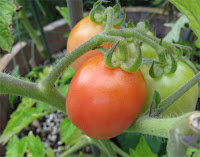
There has been no end of preserving activity as the summer bounty mounts up. Some of my tomatoes went into this oddity, Tomato Marmalade. It was excellent.

And there are tomatoes still on the vine.. playing wait and see with the early frosts.

Meanwhile, the autumn crocus is up and nearly over. Unlike cousin Shirley, who gave me these, I do not have thousands of them which would make an impressive display; but the few I have are lovely enough.

The purslane is growing leggy and starting to seed. I had thought it would flower and then seed, but I guess this is the purslane equivalent of a flower:


Each of what appear to be flower buds are actually seed pods, which open spontaneously and spill what looks like poppy seed. I've been trying to collect it which is a bit laborious but should be worth it as I'm guessing it grows easily and then propagates itself endlessly, since it was considered a weed (until its value as a source of omega 3 and other antioxidants came to light). Rather glad I planted it in a pot.




















